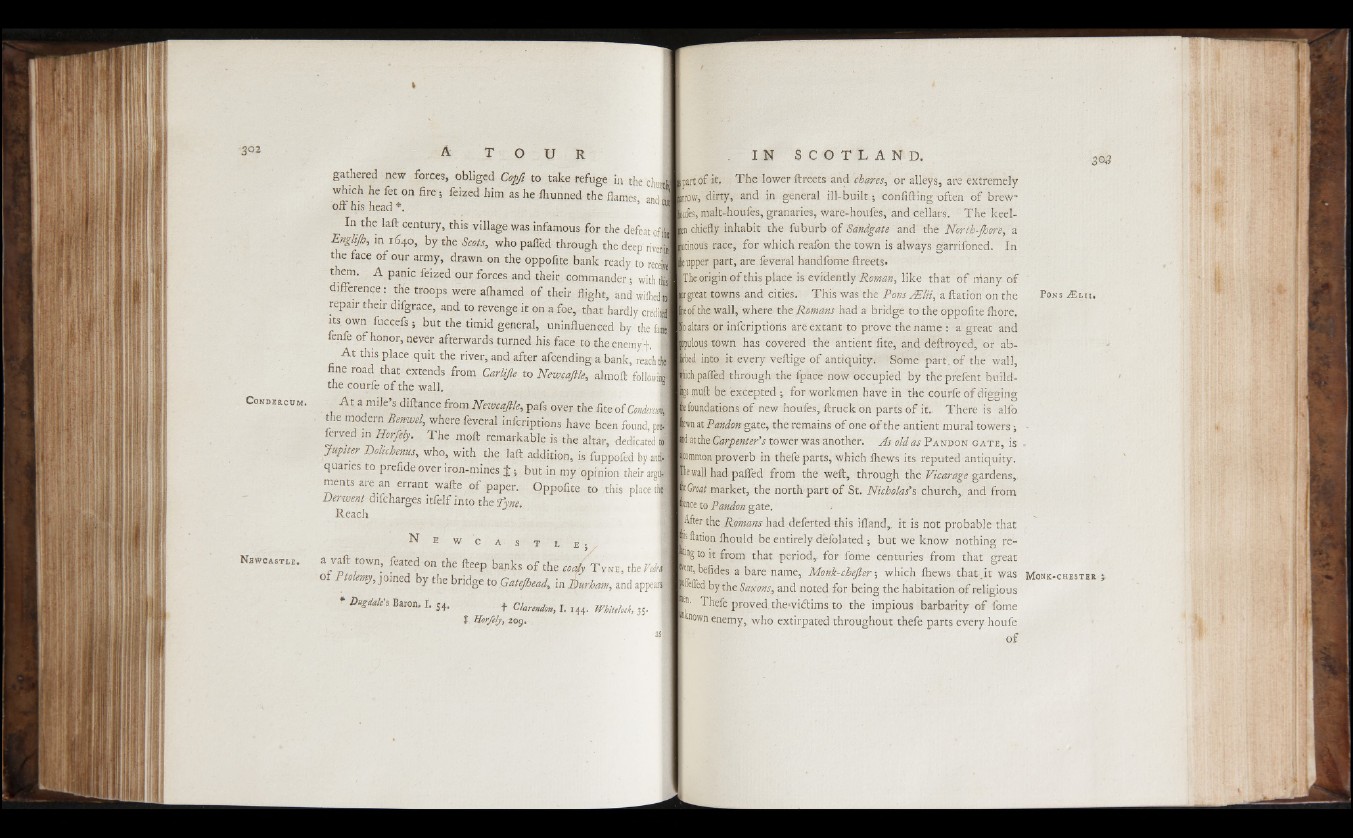
CoNDBRCUM.
N e w c a s t l e .
gathered new forces, obliged Copfi to take refuge in the c h u j
Wffh h i f fe*0n fireS feiZe<1 him ^ hC 1111111116(1 the flames> and!
In the laft century, this village was infamous for the d e fe at o f L
Englijh, in 1640, by the Scots, who pafled through the d e e p riv er!
the face of our army, drawn on the oppofite bank ready to recel
them. A panic feized our forces and their commander; with i f
difference: the troops were afhamed of their flight, and w iih ed i
repair their difgrace, and to revenge it on a foe, that hardly credit]
its. own fuccefs ; but the timid general, uninfluenced by the f a l
fenfe of honor, never afterwards turned his face to theenemyf. I
At this place quit the river, and after afcending a bank, reach tlj
fine road that extends from Carlifle to Newcaftle, almoft fo llo w ij
the courfe of the wall. j
At a mile’s diftance from Newcaftle, pafs over the fite of ConderaA
the modern Benwel, where feveral infcriptions have been fo u n d , n il
fcrved in Horfely. The moil remarkable is the altar, dedicated to
Juptter Doltchems, who, with the laft addition, is fuppofed by an ti
quanes to prefideover iron-mines J ; but in m y opinion th eir argil
ments are an errant wafte of paper. Oppofite to this place the
Derwent difcharges itfelf into thzTyne.
Reach
N 2 W C A S T L E ; ,
a vaft town, feated on the fteep banks o f the coaly T yne, th e /W
of Ptolemy, joined by the bridge to Gatejhead, in Durham, and appear!
1 Baron, t 54. f Clarendon, X. 144. Whiteloci, 3;.
t Horfely, 209.
part of it. The lower ftreets and chares, or alleys, are extremely
t o w , dirty, and in general ill-built; confifting often of brew-
jufes, malt-houfes, granaries, ware-houfes, and cellars. The lceel-
chiefly inhabit the fuburb of Sandgate and the North-Jhore, a
litinous race, for which reafon the town is always garrifoned. In
flipper part, are feveral handfome ftreets.
¡The origin of this place is evidently Roman, like that of rriany of
«rgreat towns and cities. This was the Pons JElii, a ftation on the
he of the wall, where the Romans had a bridge to the oppofite fhore.
jo altars or infcriptions are extant to prove the name : a great and
¡pulou.s town has covered the antient fite, and deftroyed, or ab-
rbed into it every veftige of antiquity. Some part, of the wall,
h pafled through the fpace now occupied by theprefent build-
b muft be excepted ; for workmen have in the courfe of digging
^foundations of new houfes, ftruckon parts of it.. There is alfo
Pwn at Pandon gate, the remains of one of the antient mural towers;
at the Carpenter’s tower was another. Asoldas P a n d o n g a t e , is
jfflnmon proverb in thefe parts, which ihews its reputed antiquity,
pc wall had pafled from the weft, through the Vicarage gardens,
fit® market, the north part of St. Nicholas’s church, and from
pee to Pandon gate.
After the Romans had deferted this ifland,. it is not probable that
p ftation ihould be entirely defolated : but we know nothin» re- .■ J - O '
mg to it from that period,, for fome r l centuries from that great pit, befides a bare name, Monk-chefter; which ihews that.it was
¡ffeffed by the Saxons, and noted for being the habitation of religious
Thefe proved the-viftims to the impious barbarity of fome
>wn enemy, who extirpated throughout thefe parts every houfe
of
Monk-chbster ;